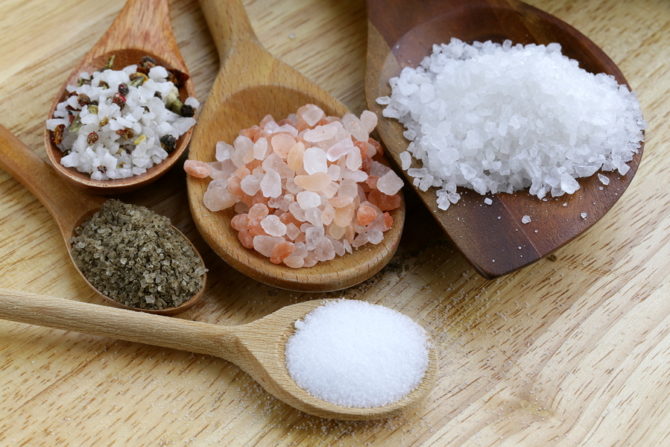This week is Salt Awareness Week and March is national nutrition month so why not pay homage to all the different types of salts that nourish us on a daily basis (and some that don’t!)
Salt Sanity
There are as many different kinds of salts are there are many ways to incorporate them into your daily diet. However, not all salt is created equal. Some are available to add to your cooking and baking and others, mainly sodium, are found in many pre-packaged foods and store bought baked goods. In fact, one of the largest misconceptions about salt is that it is the same as sodium. While they are both minerals, salt is sodium plus chloride, 40% of which is sodium and 60% of which is chloride. Sodium chloride helps our nerves transmit signals to our brains, maintain normal blood pressure, helps to relax our muscles and maintains fluid balance within our body. Needless to say, it is vital to our health as it assists in ensuring we are functioning properly. However, too much of it can run you the risk of developing diabetes, heart disease, kidney disease and high blood pressure. The key is to maintain a healthy balance by limiting your intake of processed, high sodium packaged foods.
A helpful tip for monitoring your salt intake is to read the nutrition labels. Take a look at how much sodium per serving there is. In some cases with processed foods, the amount of sodium can come close to the daily recommended amount which can contribute to all those health issues mentioned earlier. Natural foods plucked straight from the Earth also contain salt however, these are mainly trace amounts and if you are eating a plant-based diet or one that includes mostly produce and sea veggies, your salt intake should float within the acceptable levels.
Some examples of this are:
Swiss chard – 158mg/half cup
Artichoke hearts – 80mg/half cup
Dandelion, mustard, turnip, beet and collard greens – 174mg/half cup
Spinach – 80 mg/half cup
Red and gold beets – 65mg/beet
Celery, potatoes and carrots – 50mg each
It is easy to see how eating a diet rich in whole, earth based foods will supply you with the proper, healthy amount of sodium. Sea based foods are also a fantastic resource for healthy salts as they have 10 to 20 times the mineral content as their land vegetable counterparts yet, are significantly lower in sodium. Seaweed for example, an algae that can be eaten and added to recipes, contains 102mg of salt per 100g. Other sea vegetables, such as kelp, dulse, wakame, rockweed, sea lettuce and Irish moss provide all 56 trace elements required for your bodies to function at their peak performance and provide you with essential sodium balanced with potassium.
Combining greens such as kale and spinach with sea vegetables is like giving your body a dose of superfoods with minimal sodium. What about adding salt as flavouring? Some foods just needs that extra pinch to bring out their natural flavours. Luckily, our planet is rich in natural minerals and provide us with a great variety of salts to sprinkle on our dishes. Lets take a look at some different kinds of salts and what they work best with.
Celtic Sea Salt
Naturally harvested in Brittany, France, near the Celtic Sea, the salt fields are lined with a natural layer of sand and clay that is rich in vitamins and minerals. This salt is moist due to the mineral rich brine in which it was created and will retain that moisture regardless of how it is stored. Celtic salt is greyish in colour due to its mineral properties and dissolves faster in water than conventional salt. The coarse variety is perfect when sprinkled on your completed dishes or while cooking and the whole crystal variety is commonly used by culinary chefs to garnish desserts.
Himalayan Sea Salt
This beautiful pink salt, believed to be composed of dried remnants of the original, primal sea dating back to Earth’s creation, is considered by many to be the purest on our planet due to it’s incredible nutrient load. It contains all of the 84 elements found within our bodies and has been used for everything from adding to recipes to promoting sinus health and regulating sleep. This salt is truly a powerhouse of health! In addition to seasoning dishes, Himalayan salt can also be used in bath products and carved into lamps which emit positive energy waves.
Kosher Salt
It is made from the salt crystals left over from either evaporated sea water or from pumping water into salt rock deposits in salt mines. It is coarser than other salts and can very in shape depending on the brand. It does not dissolve right away so when you sprinkle it on foods you can see where you’ve added it and how much. No over-salting with kosher! This kind of salt is great for adding to vegetables before cooking and is also great to use when a recipe calls for “coarse salt”.
Refined Table Salt
This is the kind of salt routinely found in salt shakers in restaurants and many home kitchens. It is made by taking natural salt and baking it at 2,100 degrees Fahrenheit. This process destroys all of the naturally occurring minerals our bodies need to be healthy. Processing also means the salt now contains additives such as ferrocyanide (an anti-caking agent), talc (a separating agent and known carcinogen), silica aluminate (another chemical anti-caking agent) and toxic amounts of potassium iodide, also known as KI (a compound which should be taken only on the advice of a medical professional). High ingestion of refined table salt has been linked to numerous health issues including high blood pressure, diabetes, gout and obesity. When combined with the preservatives in pre-packaged food, it can cause or contribute to kidney, thyroid and liver problems, goiters, hypertension, heart disease, edema, stroke etc etc. The list goes on. Not healthy stuff at all! Should you wish to add salt to your foods, stay far away from refined table salt and instead select one of the others mentioned above.
Iodized vs Non-Iodized
Iodized salt is salt that is mixed with a small amount of iodine, that of which is important in preventing iodine deficiencies, which can cause issues with the thyroid gland and can contribute to goiters and intellectual disabilities. Non-iodized salt is salt which does not have the compound iodine added to it. If you are eating a diet rich in healthy, plant-based foods and sea vegetables, your body would be receiving an adequate amount of iodine.
So there you have it! Lots of options for salt and especially what to avoid. Go forth and try out different salts but remember to monitor your intake of added salt so you do not exceed the daily recommended amount. Bon appetite!


